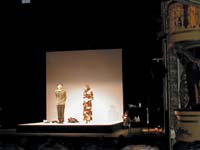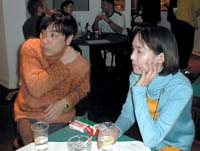Turning the Criminally Absurb into Art
Back to Contents of Issue: February 2003
|
|
|
|
by Sohbi Iida |
|
 ISSEY OGATA AND KAORI Momoi are turning absurdity and violence into laughter at the Playhouse Theater in London's West End on this fall day. Ogata, playing a member of the former Aum cult, stands on the almost empty stage and mutters: "I am getting confused whether I really think this way, or I am forced to think this way." ISSEY OGATA AND KAORI Momoi are turning absurdity and violence into laughter at the Playhouse Theater in London's West End on this fall day. Ogata, playing a member of the former Aum cult, stands on the almost empty stage and mutters: "I am getting confused whether I really think this way, or I am forced to think this way."In another sketch, Momoi, playing a young woman whose mother and brother have been brutally murdered, has a conversation with her father, Ogata. "Did I ever tell you to go see a psychiatrist? No. I never did," the father bellows. "You said that you wanted to go. Isn't that right?" "Yes, father," the daughter replies, "because I knew that if I went to the doctor, you would release your anxieties and feel better." Welcome to the twisted world of Momoi and Ogata, taken straight from the front pages of Japan's newspapers -- youth crimes, cult attacks and horrible murders all serve as material for this two-person performance. In the end, their darkly humorous sketches transcend cultural boundaries and unite this London crowd in laughter. "I thought their scripts and delivery were excellent," said Joe Kargno, a local masseuse and writer, who was experiencing Japanese theater for the first time. "Their sense of humor was funny, but very different from ours. Their themes were radical and very serious, yet they made jokes out of them. I felt like I saw a face of the Japanese society where people smile on the surface, but they have a lot of struggles inside as they live in such a strict society. I would definitely go see their shows again." The non-Japanese audience made up about one-quarter of the crowd of 700 on this night, and they seemed either totally perplexed or really engaged and excited by the show. Some said they regretted that they couldn't appreciate the Japanese sense of humor and conversation, which was translated for the headset-wearing audience members. Momoi and Ogata's subject matter is familiar news for people living in Japan: murders carried out by a 14-year-old in Kobe in 1997; a Tokyo mother who killed her neighbor's 2-year-old daughter in 1999; the murder of Lucie Blackman, a club hostess and former flight attendant, in 2000; and Aum's sarin gas attacks in 1995. The two turned these darkest of memories into humor by portraying the actors of these crimes and their family members. But why?  "We didn't start with a journalistic approach," Momoi said in an interview after one of their performances. "It was just that we happened to hear about so many brutal murders in the news that we couldn't logically comprehend. The fact is that these murder cases went beyond fiction in their absurdity and injustice. But we had no clue as to what it was like to be involved in such events. We thought that by acting as the parties involved, we could somehow implicitly understand their feelings and share them with the audience through laughter. At the end of the day, despite all the absurdities in society, all of us, including the criminals and the families of the victims, still have to live our lives."
"We didn't start with a journalistic approach," Momoi said in an interview after one of their performances. "It was just that we happened to hear about so many brutal murders in the news that we couldn't logically comprehend. The fact is that these murder cases went beyond fiction in their absurdity and injustice. But we had no clue as to what it was like to be involved in such events. We thought that by acting as the parties involved, we could somehow implicitly understand their feelings and share them with the audience through laughter. At the end of the day, despite all the absurdities in society, all of us, including the criminals and the families of the victims, still have to live our lives."Ogata added: "There were many scenes where we instantly responded with laughter, but then we wondered why we thought they were funny." Kenichi Asano, a scholar and journalist specializing in crime reporting, said, "What was most remarkable about their play was that they saw and performed from the perspectives of the families of the criminals. It is easy to feel sympathy and see things from the side of the victims, but not from that of the criminals." This is not the first time for Ogata to take his act overseas. He has performed in London five times, prompting The Guardian, a leading British daily paper, to call him "an international man of mystery" and "a precise performer with brilliant mimes." Issey is, of course, very popular in Japan as well -- his one-man shows usually sell out in minutes. Issey is no typical entertainer, either -- he worked as a day laborer while writing his first scripts. After a hard day of physical labor, he would meet with Yuzo Morita, his long-time director (and the director of the London shows) to work on his writing. It was in the 1980s that he began performing his shows in a tiny cabin, developing a unique style that included changing costumes in front of the audience. Momoi is even better known than Ogata in Japan. She made her debut in 1971 and became one of Japan's most popular actresses, winning numerous awards and prizes for acting in films, theater and television. She has also released 15 albums as a singer and regularly holds jazz concerts. Despite her fame, she has struggled at times because she is seen as being outspoken in an industry that wants its women to just be beautiful. "There are too many things in life that cannot be settled by our likes and dislikes," she said. "We don't know how our plays will be until we actually create and perform them. Likewise, we cannot understand our lives until we actually live them." @ |
|
Note: The function "email this page" is currently not supported for this page.





